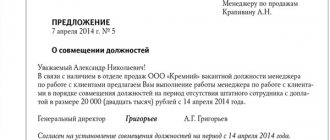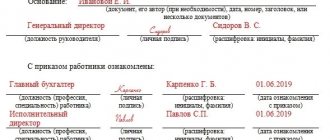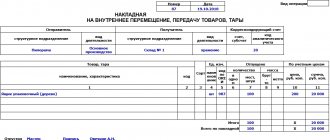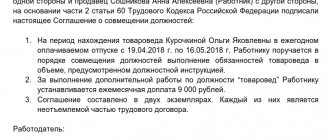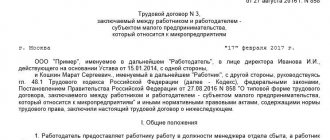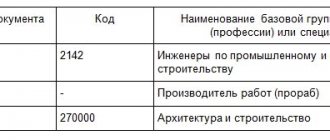Home / Labor Law / Employment / Part-time and part-time work
Back
Published: 08/10/2016
Reading time: 8 min
0
5859
Labor legislation allows additional work activity for those working citizens who want to get a part-time job and increase their monthly income. There are two main types of such activities - part-time and combination.
Combination usually means three types of work functions: temporarily replacing an absent colleague, expanding the area of responsibility (the employee is busy with additional work in his own profession) or classic combination (performing duties in two professions at once - his own and those related to the vacancy).
In all of these cases, the employee copes with additional responsibilities without interrupting his main activity, that is, during working hours limited to one shift.
- Additional payment amounts
- Formula and calculation examples For part-time work
- Full time
- When paying for production
- If the employee did not work all working days
Is it a right or a duty?
Establishing a combination is the right of the employer to assign additional responsibilities to the employee. At the same time, a person has the right to refuse such a fate, since an agreement has already been concluded with him to perform specific job duties.
There are several types of additional work:
- Combining positions is often found to perform duties in another profession (position). For example, the company does not have a specialist for the position and employees are forced to work at essentially two rates.
- Expansion of the service area is associated with the implementation of expanded tasks, but not specified in the main job description. This may be temporary, for example, during repair work in production.
- An increase in work volume is usually temporary during the period of production growth. For example, seasonal increase or new product launch.
- Fulfilling the duties of a temporarily absent employee means temporarily replacing an absent employee and performing his functions in full or in part.
For such work, an additional agreement to the contract must be drawn up and an order is issued. A job description is written, which indicates a list of new responsibilities. When temporarily replacing duties, an employee can fully perform the work assigned to him and devote only part of his time to his position. If there is a complete transition to a replacement rate, you need to arrange a temporary transfer of the person until the main employee leaves.
In accordance with the law, any combination or increase in work must be additionally paid (Article 151 of the Labor Code of the Russian Federation). In this case, the period for completing duties can take from several days to several months.
If the dates are known, it is better to immediately reflect them in the documents. The employee has the right to refuse additional workload early. To do this, he writes a corresponding statement to the manager with a request to remove the combination from him.
Combination or replacement?
Labor Code of the Russian Federation in Art. 60.2 distinguishes between these concepts. The difference is whether the remaining employee performs only other people's duties (substitution) or does it by finding an opportunity for additional work without compromising his own (combination).
Question: Is the employer obliged to increase the employee’s additional payment for combining positions (doing the work of a resigned employee), if it is established in a fixed amount under an additional agreement to the employment contract? View answer
Temporary replacement
It is used when the position left by the employee during the vacation is quite responsible and qualified - most often managerial. In order to perform all the duties provided for in full, the deputy employee will have to temporarily leave his direct functions. Such a temporary assignment may be a significant test of competency and may be a precursor to subsequent promotion.
IMPORTANT! Such a load cannot be too long: the law allows the use of temporary replacement for no longer than 1 month.
Substitution does not involve an increase in regular pay unless a higher position is being filled temporarily. Then the employee will be paid the difference in salary (paragraph 2 of clause 1. Explanations of the Ministry of Labor No. 30 of January 20, 2001). It must be remembered that the remuneration of a temporary deputy cannot be lower than what was paid for his regular position under the employment contract.
Temporary combination
Combining positions during vacation can be defined as the performance of the duties of an employee who is temporarily absent from the workplace, without releasing or reducing his own labor function. It, unlike replacement, due to an increase in workload, provides additional monetary remuneration for work.
The same scheme can apply in the case of other reasons for temporary absence, except for vacation on a long business trip or while on sick leave.
Expansion of responsibilities
Another way to ensure that the work of an absent employee is completed is to assign his duties to another employee.
This path is possible if the employees had the same qualifications and a similar job function, and the staffing table allows you to temporarily combine two positions into one.
This method, unlike the previous two, does not limit the rights of the employer, since the performance of all functions for a particular position is reflected in the employment contract, and in this case the boundaries of the positions are simply expanded, but the terms of the contract are not violated. This route does not provide for additional payment or employee consent.
Combination restrictions
The code does not contain information about restrictions on combining positions. Almost any employee in an organization can be assigned this type of work. There are two important factors to consider:
Any combination must be included in working hours, and not in excess of its norm.
It is advisable to combine positions of similar professions or employee qualifications. This is due to more competent performance of duties without wasting time on training.
However, we should not forget about the privileged category of citizens: pregnant women, disabled people, minor employees and mothers with children under three years of age. Although the law does not prohibit them from increasing the load, it is better to insure against unpleasant consequences. To do this, you can discuss all working conditions, assess their applicability to these individuals and sign all the necessary documents.
The concept of “Combining positions”
We can talk about the concept of “combining positions” if a person performs the duties of an absent person during his working hours. If he has to work overtime, then in this case we are talking about payment for hours outside working hours.
The main provisions for regulating the labor duties of employees are contained in the Labor Code of the Russian Federation. We list the rules regarding combining positions.
| Art. 60.2 Labor Code of the Russian Federation | The employee must confirm his consent in writing. |
| Art. 151 Labor Code of the Russian Federation | Mandatory payment is required for additional work. It is established by agreement of the parties. |
There are no restrictions on combining positions. But there is a circle of privileged citizens whom it is better not to burden with additional work. These include:
- minor children;
- disabled people;
- mothers with children under 3 years of age.
If the employer nevertheless decides to involve these persons in additional work, then it is necessary to obtain written consent from them and document everything.
Size in 2021 according to the Labor Code of the Russian Federation
The law does not define the scope of payment for performing work involving combining professions or replacing a temporarily absent employee. But when setting compensation, you should remember some rules:
- working conditions and remuneration should not worsen the validity of the employee’s main employment contract;
- for each combination or performance of duties, a certain amount of additional payment is assigned, which is specified in the additional agreement. It can be expressed either as a percentage of the employee’s salary or as a fixed amount;
- the additional payment is equal to compensation payments and income tax is withheld from it;
- the additional payment is included in the average salary and a regional coefficient and a percentage increase are applied to it;
- It is logical to establish an additional payment, the amount of which will not exceed the payment for the position being filled.
In the absence of an agreement on additional payment or non-payment, the work is considered illegal, as it violates the rules of the Labor Code. Such an action by the employer must be suppressed by regulatory authorities, and the employee has the right not to carry it out.
Payment amount calculation
The difficulty here is that there is no specific unified formula by which the amount of additional payment for combination is calculated. In addition, the Labor Code of the Russian Federation does not prescribe a minimum and maximum size for it.
If we turn to practice, the amount of additional payment is established in the form of an agreement between the employer and his employee. It is influenced by the following factors:
- The complexity of the work being performed.
- Scope of activity.
- When working part-time in a combined position, the volume of actually completed tasks is taken into account in proportion to the time spent.
- The employer has the right to reduce or completely stop the additional payment in cases where the quality of the work performed, products produced or services provided has deteriorated.
- The employee is notified in writing about any change in the conditions of the combination (including its payment).
- With a time-based salary, the amount of additional payment for part-time work is usually associated with the amount of work performed and the tariff rate at which it is remunerated.
- For piecework wages, the additional payment for combined work is based on increased piecework prices.
- When combining a position for which time-based pay is applied, the bonus is calculated based on the percentage of the salary or the tariff rate for it.
Although there are no specific acts regulating the amount of additional payment, there is a rule: it should not be higher than the full rate for the combined profession or position. This is expressly stated in Art. 423 TK. Such a requirement is not new for the Russian Federation. A similar rule was established back in Soviet times.
If the employer ignores this instruction, this may result in a serious problem for him with the tax service.
From what salary is it calculated?
The question of establishing compensation for performing temporary duties or combining professions often arises when such a situation arises. When performing duties, compensation is calculated based on the salary of the absent employee.
It is quite rare for a deputy to be paid a full salary; usually a certain percentage is established. When combining professions, it is quite appropriate to pay the full salary or part of it, depending on the time spent. When the volume of work increases, it is worth calculating the percentage of the bonus from the employee’s salary.
It should be noted that there are no specific payment rules, upper and lower limits of compensation. The decision is made on the basis of a collective agreement or internal local documents of the company.
Where is the amount of additional payment for combination indicated?
The calculation of the amount of payments to employees combining several positions is usually made by the company's accountant. However, the employee may be no less interested in the amount of the additional payment. Then he wonders where to see the amount due. It is important to understand that such information appears in the following documents:
- Notice of combination . It specifies the amount of additional payment at the request of the employer. This is usually done so that the employee becomes interested in the offer made to him and agrees to the conditions put forward.
- Additional agreement . It is concluded if the employee and the employer have reached a mutual decision. This document specifies the amount of the premium. This is official information, and it is in accordance with them that payments will be made in the future.
- Employment contract . The specific amount for the combination is not indicated here, but the document may specify the mechanism for calculating the additional payment depending on hours, output or other characteristics.
The order for combination may not contain specific numbers. Some employers only stipulate in internal documents the conditions for performing additional duties (for example, an additional salary).
Calculation procedure
Additional payment can be set in two ways: a fixed amount or a percentage of the salary for the position being filled.
When choosing compensation that is a certain percentage of salary, you must first calculate the amount based on the established percentage.
Example: for combining a position, a person receives 50% of 20 thousand rubles. This amounts to 10 thousand rubles. The employee's salary is 30 thousand rubles. Thus, wages are calculated as (30,000 + 10,000) – 13% personal income tax = 34,800 rubles.
It is important to remember that compensation is calculated in proportion to the time worked if the month was not fully worked.
Combination features
Combination is a form of relationship between an employer and an employee in which the latter performs additional functions during his working hours for an additional fee. This should not affect the results of work in the main position.
Most often, employers resort to internal part-time work in the following formats:
- the combination is temporary until the employee whose duties have been taken over by another employee returns to work (may be on vacation, on sick leave, etc.);
- an increase in the employee’s workload (without changing his specialization, for example, if a second position of the same type is vacant);
- The employee combines different positions.
Part-time work is voluntary. The employee himself decides whether to agree to it or not. During the discussion of further actions, he may not agree with the amount of payment - then the employer himself decides whether there will be a necessary additional payment for combining positions or whether additional responsibilities will not be assigned to the employee.
During vacation
The most common occurrence when it is necessary to register a combination of positions is the vacation of one of the company’s employees. Most often, a temporary executor is appointed for the period of vacation of the main employee.
In any case, an additional agreement and an order for combination or replacement are drawn up. The job responsibilities that the employee must perform during his working hours are specified separately. The peculiarity of such work is its short duration.
Usually the vacation dates are known and are written down in all documents. This type of combination is called “for the period of vacation of the main employee.” Compensation for the bonus is paid for the entire period of work. If it lasts less than a month, it is calculated in proportion to the time worked.
Categories
Article 151 of the Labor Code of the Russian Federation “Remuneration for combining professions and performing the duties of a temporarily absent employee” determines that an employee who performs for the same employer, along with his main work stipulated by an employment contract, additional work in another profession (position) or performing duties a temporarily absent employee without release from his main job, an additional payment is made for combining professions (positions) or performing the duties of a temporarily absent employee.
The amount of additional payments for combining professions (positions) or performing the duties of a temporarily absent employee is established by agreement of the parties to the employment contract.
Article 151 of the Labor Code of the Russian Federation is a kind of continuation of Art. 149 of the Labor Code of the Russian Federation regarding wages when combining professions (positions).
In relation to workers we are talking about combining professions, and in relation to employees - about combining positions. Professions are assigned on the basis of the Unified Tariff and Qualification Directory of Workers' Professions (UTKS) or the Qualification Directory (QD) of worker professions not included in the ETKS. Specialists and employees occupy positions.
It is advisable to combine professions (positions) within the category of personnel to which the given employee belongs (workers, employees, etc.).
Combining professions (positions) means performing additional work in another profession (position) along with one’s main work stipulated by an employment contract.
The difference from part-time work is that in addition to the main job, the employee performs other work within the working hours established for the main job due to the intensity (condensation) of work during the working day.
The performance by an employee, along with his main job, of an additional volume of work, but in the same profession (position), is considered as an expansion of service areas or an increase in the volume of work performed (this is not a combination).
Both those and other types of work are allowed at the same enterprise, institution, organization with the consent of the employee during the duration of the working day (shift) established by law, if this is economically feasible and does not lead to a deterioration in the quality of products, work performed, or service population.
The concept of expanding service areas or increasing the volume of work performed is given in Art. 423 of the Labor Code of the Russian Federation “Application of laws and other normative legal acts.” It establishes that, pending the bringing of laws and other normative legal acts in force on the territory of the Russian Federation into conformity with the Labor Code of the Russian Federation, laws and other legal acts of the Russian Federation, as well as legislative acts of the former USSR in force on the territory of the Russian Federation within and the procedures that are provided for by the Constitution of the Russian Federation, Resolution of the Supreme Council of the RSFSR dated December 12, 1991 No. 2014-1 “On the ratification of the Agreement on the creation of the Commonwealth of Independent States” are applied insofar as they do not contradict the Labor Code of the Russian Federation.
Regulatory legal acts of the President of the Russian Federation, the Government of the Russian Federation issued before the entry into force of the Labor Code of the Russian Federation and decisions of the USSR Government applied on the territory of the Russian Federation on issues that, in accordance with the Labor Code of the Russian Federation, can only be regulated by federal laws, are valid until the entry into force of the relevant federal laws.
In accordance with the Decree of the Council of Ministers of the USSR dated December 4, 1981 No. 1145 “On the procedure and conditions for combining professions (positions)”, the USSR State Committee for Labor and Social Issues, together with the USSR Ministry of Finance and the All-Union Central Council of Trade Unions, was developed on May 14, 1982 No. 53-VL Instructions for the application of Resolution of the Council of Ministers of the USSR of December 4, 1981 No. 1145 “On the procedure and conditions for combining professions (positions).” It defines what it means to expand service areas and increase the volume of work performed.
In case of temporary absence of an employee (for example, due to illness, business trip, vacation or for any other reason, when his place of work is retained), his position and work responsibilities may be assigned to another employee, but without release from his main job.
Based on Art. 151 of the Labor Code of the Russian Federation in this case provides the right to establish an appropriate additional payment.
The amount of additional payments for combining professions (positions) or performing the duties of a temporarily absent employee in accordance with Art. 151 of the Labor Code of the Russian Federation are established by agreement of the parties to the employment contract.
The specific amount of a particular surcharge is reflected in the local regulatory act of the enterprise (for example, an order for the enterprise). The order must indicate:
• what kind of work the employee does;
• workload;
• this or that additional payment is established as a percentage of the tariff rate, salary or in absolute size and for what period (month, half a year, etc.).
Additional payment for combining professions (positions) must be made differentially. When agreeing on the specific amount of additional payments for combining professions (positions), one should take into account the importance of the additional work assigned, its volume, and the employee’s workload in the main position held.
In practice, the amount of additional payments established for an employee for combining professions (positions) is not limited by the maximum amount. For one vacant position, additional work may be assigned to several employees. However, the total amount of additional payments should not exceed the savings on the wage fund for vacant positions.
The collective agreement (another local regulatory act, for example, in the personnel regulations or in the regulations on remuneration) must reflect combination options, including by position and profession.
In order for the accrual of bonuses when combining professions or positions (accrual is made according to the main job) to be made taking into account the amount of additional payments for combining professions (positions), in the collective agreement (another local regulatory act) it is necessary to determine the list of additional payments and allowances to the tariff rates and official salaries of employees of this enterprises for which bonuses are awarded, taking into account available funds.
Regulation of the procedure and amount of additional payment for performing duties in the profession or position of a temporarily absent employee must be reflected in the collective agreement of the enterprise or other local regulation. Such a document at enterprises where collective agreements are not concluded, as a rule, is the Regulations on the personnel of the enterprise, adopted at a meeting of the labor collective. Both workers and employees have the right to replace a temporarily absent employee. But due to the fact that additional payments for replacing temporarily absent workers are made mainly due to savings in the wage fund, taking into account production needs and the availability of wage fund savings, the list of workers who may be entrusted with this replacement must be reflected in the collective agreement or other local regulations.
The specific amount of additional payment in absolute amount or as a percentage of the official salary or tariff rate of an employee who, along with the main job, is entrusted with performing the duties of a temporarily absent employee (due to vacation, illness and other cases) is established by order of the enterprise.
In order for bonuses to be calculated when performing the duties of a temporarily absent employee, taking into account the amount of the established additional payment, it is necessary to include this additional payment in the list of additional payments and allowances to the tariff rates and official salaries of employees of this enterprise, for which bonuses are calculated. The specified list should be included in the collective agreement (another local regulatory act, regulation on remuneration).
Example.
In the organization, during the absence of an accountant (study leave, then another leave), the volume of his work was assigned to the standard setter. In this case, is the standard setter entitled to additional payment for performing the duties of a temporarily absent employee? Will it be taken into account when calculating the bonus?
The imposition on an employee (in this case, a standard setter) of additional duties of an absent employee (accountant) within the duration of the main working time in connection with educational and regular leave, when, in accordance with the current legislation, his job or position is reserved for him, is considered by labor legislation as fulfillment duties of a temporarily absent employee.
In the example given, the following should be used as a guide. Based on the current legislation and the collective agreement, the standardizer may be paid an appropriate additional payment. An order is issued for the enterprise indicating:
– additional volume of work performed;
– the deadline for fulfilling the duties of a standard setter for an accountant;
– a specific amount of additional payment (for example, 50% of the salary for the main job).
If the collective agreement provides for a list of additional payments and allowances to the tariff rates and official salaries of employees for which bonuses are calculated, then a bonus will be calculated for the additional payment established by the standard setter.
If the work of an accountant is assigned by order equally to several employees (for example, three), then the establishment of additional payments is possible both equally and differentiated depending on the specific additional volume of work performed by each employee separately (the first, for example, 30% of the official salary for the main job, the second - 20%, the third - 50%). The amount of additional payment to employees may be limited to the salary of the absent employee (accountant).
The question arises about the legality of establishing additional payments for part-time work for the head of the enterprise, his deputy and the head of the structural unit. In sub. “a” paragraph 15 of the resolution states that it does not apply to heads of enterprises, institutions and organizations, their deputies and assistants, chief specialists, heads of structural units, departments, workshops, services and their deputies. To the leaders
in particular,
they include:
– directors (general directors), chiefs, managers, managers, chairmen, commanders, commissioners, foremen, work performers at enterprises, structural units and divisions;
– chief specialists - chief accountant, chief dispatcher, chief engineer, chief metallurgist, chief welder, chief agronomist, chief geologist, chief electrician, chief economist, chief researcher, editor-in-chief;
- government inspectors.
The category of managers also includes deputies for the above positions.
For example, if there is no chief specialist, then the head of the department can instruct the leading specialist to carry out additional work to ensure control over the expenditure of the wage fund, bonuses, the use of forms and systems of remuneration, and the establishment of categories of workers and categories of employees. In this case, the leading specialist may be given an additional payment for holding multiple positions.
The head of the department can conduct this area of work himself during the absence of the chief specialist. In this case, he cannot be given an additional payment for combining the position of a chief specialist, since for the head of a department this is not an additional volume, but the main job.
According to paragraph 34 of the Instructions on statistics of the number and wages of workers and employees at enterprises, institutions and organizations, managers include employees holding positions of heads of enterprises and their structural divisions. The position of a manager according to the All-Russian Classifier of Worker Occupations, Clerk Positions and Tariff Grades has code 1.
The answer to the question about the legality of establishing an additional payment for a part-time job for the head of a structural unit is the decision of the Cassation Board of the Supreme Court of the Russian Federation dated March 25, 2003 No. KAS 03-90 on recognizing it as invalid from the date of this decision, sub. “a” clause 15 of the resolution of the Council of Ministers of the USSR of December 4, 1981 No. 1145 “On the procedure and conditions for combining professions (positions)” (as amended by resolutions of 02/19/87 No. 222; 12/01/87 No. 1367; 02/05/88 No. 153; 05.31.88 No. 689; 08.17.89 No. 657) regarding the words: “heads of structural units, departments, workshops, services and their deputies.”
Thus, sub. “a” clause 15 of the said resolution regarding the words: “heads of structural divisions, departments, workshops, services and their deputies” was declared invalid from the date of the ruling.
Application, order for combination
Any employee’s work duties must be documented. The employer issues an order for this purpose. The document contains information about the employee who is responsible for combining, replacing or increasing the area of responsibility.
If deadlines are known, they must be indicated or the justification for increasing the workload and expanding job responsibilities is written down. An agreement is also drawn up with the employees, which specifies all the working conditions, including payment.
To prevent conflicts, it is better to take a statement from the employee in which he gives his consent to perform additional work. This is especially important to do with a privileged category of workers (pregnant women, disabled people, minors, mothers of young children).
What determines the amount of the surcharge?
Percentage and absolute allowances for performing additional functions are usually established in enterprises where it is impossible to evaluate the employee’s effectiveness, in contrast to production, where piecework wages are often used. However, in this case, there are certain criteria that affect the amount of the due payment, namely:
- scope of functions;
- complexity of the work (whether additional knowledge or skills are needed);
- availability of deadlines for implementation (urgent/not urgent);
- employee workload.
The employee himself, when deciding whether to accept the employer’s offer, must also evaluate these factors. It would be good to calculate the cost of an hour of work and compare it with the cost of the main position.
